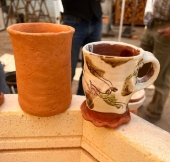
 5
5




:max_bytes(150000):strip_icc():format(webp)/parts-of-a-swamp-cooler-2718628-a477e6f0787b4f8bb62ddf2def31d495.png)
There is madness to my method.
"Life finds a way"- Ian Malcolm
"We're all mad here" - The Cheshire Cat




Garden Master Program video course and ebook guide
 4
4




 2
2




SKIP books, get 'em while they're hot!!! Skills to Inherit Property
See me in a movie building a massive wood staircase:Low Tech Lab Movie
 2
2




Mike Haasl wrote:To clarify...
You're asking if a rocket kiln can make unglazed materials for use in an air cooling device, right?
or
You're wondering if a rocket kiln can make the air cold somehow?
If it's the latter, I think it's a hard no.
There is madness to my method.
"Life finds a way"- Ian Malcolm
"We're all mad here" - The Cheshire Cat




Mike Philips wrote:
A technology that can work without a lot of water consumption and can work in areas with high humidity is a desiccant based dehumidifier. A common desiccant that is used is calcium chloride salt. It is effective, non-toxic and low cost.
The way it works is when you have a very salty brine, say 30% (mass) salt, it will actually pull humidity out of the air. This water entering the brine will dilute it to say a 20% solution. A heat source such as solar or biomass energy can be used to evaporate off some of the water (and distill/condense it if desired), to return the brine to the original concentration. That condensed water could then to used in a swamp cooler evaporator for example.
Mike Philips wrote:
Another technology you mentioned, a radiative cooler, is a lot like a solar cooker but in reverse. 1) you need clear skies, 2) a basic optical design, 3) insulation, 4) thermal storage if you want an extended effect.
Mike Philips wrote:
One difference is that with a solar oven, glass is often used for the window because it reflects some infrared and the greenhouse effect is an advantage for heating. However with a radiative cooler, you want the opposite of the greenhouse effect. A different clear material might be suitable, or the window could be omitted.
Mike Philips wrote:
Another technology is to use air as the working fluid in a compression refrigeration cycle. This is preferably done with 2-phase flow, say air and liquid water. One well-known design is the “Trompe”. Bill Mollison was a fan of. Traditionally they ran on hydropower, but I see no reason why they couldn’t be adapted to run on other sources such as solar electric or wind.
There is madness to my method.
"Life finds a way"- Ian Malcolm
"We're all mad here" - The Cheshire Cat
 3
3




Cat Knight wrote:
Are you saying to draw water out of the air through chemistry, and then use it to provide the water to the clay pieces?
Cat Knight wrote:
Are you suggesting this method so that it uses absolutely no power other than from the sun to evaporate and concentrate the water?

Cat Knight wrote:
I was thinking a fountain pump that was solar powered…
Cat Knight wrote:
but it sounds like this might also work. I suspect that where I personally would deploy it (near Winemucca NV) I may not have enough moisture to pull from the air with that method.

|
this tiny ad cannot hear you because of the banana
Learn Permaculture through a little hard work
https://wheaton-labs.com/bootcamp
|




